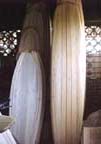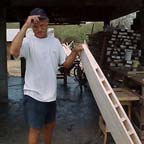 The boards are then glassed, sometimes with one
sheet of six-ounce cloth, other times with more, depending on the
weight and strength of the balsa and the construction. Andres uses
resin and glass imported from the United States, or adapted from
boating materials available in Guayaquil, the largest city in
Ecuador. Assisted by three Ecuadorean helpers, it takes Andres
about 45 hours to make a "Balsa Flite" surfboard. Balsa is not the
easiest material to work with, but it's a real challenge for the
surfboard shaper who prides himself on craftsmanship. An
experienced balsawood shaper might spend an average of 10-12
hours, just in shaping alone. Andres explains that his balsa
surfboards are much stronger than commercially produced fiberglass
surfboards. A well-made balsa board should last at least 10 years
when well cared for. Balsa Flite surfboards are functional in a
variety of surf breaks as well as a beautiful piece if
craftsmanship.
The boards are then glassed, sometimes with one
sheet of six-ounce cloth, other times with more, depending on the
weight and strength of the balsa and the construction. Andres uses
resin and glass imported from the United States, or adapted from
boating materials available in Guayaquil, the largest city in
Ecuador. Assisted by three Ecuadorean helpers, it takes Andres
about 45 hours to make a "Balsa Flite" surfboard. Balsa is not the
easiest material to work with, but it's a real challenge for the
surfboard shaper who prides himself on craftsmanship. An
experienced balsawood shaper might spend an average of 10-12
hours, just in shaping alone. Andres explains that his balsa
surfboards are much stronger than commercially produced fiberglass
surfboards. A well-made balsa board should last at least 10 years
when well cared for. Balsa Flite surfboards are functional in a
variety of surf breaks as well as a beautiful piece if
craftsmanship.
 Gringo Andres has made about 2,000 balsa
surfboards over the past 25 years, but today, he focuses more of
his attention on constructing balsawood longboard and gun blanks.
He is using the same technique that Tom Blake used more than 40
years ago, shaping balsa around a hollow core. But going back to
the past doesn't make Andres uncomfortable. In fact, it's the
connection with the past that first attracted him to Playas and
keeps him there. Says Kozminski, "There's lots of surf, lots of
sun, no crowds, and plenty of time to enjoy it all."
Gringo Andres has made about 2,000 balsa
surfboards over the past 25 years, but today, he focuses more of
his attention on constructing balsawood longboard and gun blanks.
He is using the same technique that Tom Blake used more than 40
years ago, shaping balsa around a hollow core. But going back to
the past doesn't make Andres uncomfortable. In fact, it's the
connection with the past that first attracted him to Playas and
keeps him there. Says Kozminski, "There's lots of surf, lots of
sun, no crowds, and plenty of time to enjoy it all."